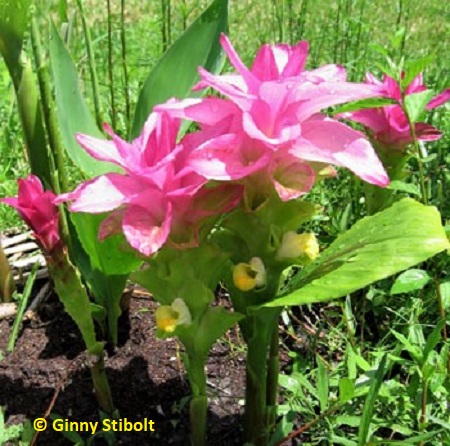Adventures of a Transplanted Gardener |
|||||||
Hidden ginger lilies and other intriguing monocots
| |||||||
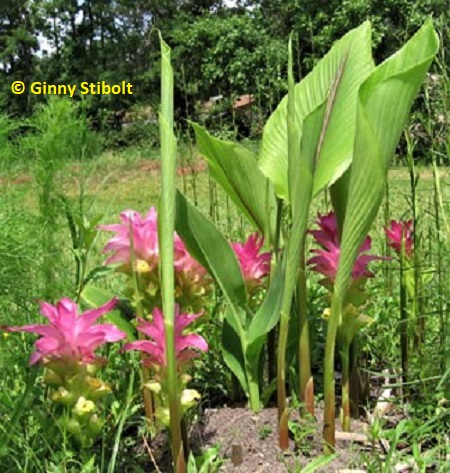 |
The mystery plant is identified!
<< This spring, the flowers for the plant with the big tropical leaves have been fabulous. At this point the leaves are just barely getting started and in the middle of the clump is a stray Canna. I decided it was time to figure out what the devil we were dealing with.
I asked some of the gardeners in the neighborhood and looked in people's gardens to see if I could see any others—no luck. I looked in some nurseries—still no luck. I sent a photo to my botany professor—she's not into "tropicals." Finally, I talked to Jack Scheper at Floridata.com and he said that it sounded like a Curcuma. He was right.
I researched the internet and have decided that this is probably a hidden ginger lily (Curcuma petiolata). Turmeric (C. longa) is a related species. They're related to ginger. Most of these plants are native to Asia and have been used as medicinal herbs for various ailments for centuries. One herbal related that, "the effectiveness has yet to be determined."
My husband and I are enjoying the amazing hidden ginger lily flowers this spring and look forward to its tall tropical leaves later in the season.
Three other interesting monocots
Flowering plants (Angiosperms) are divided in to two groups: monocots and dicots. Most of the seeds we plant for our gardens are dicots with two seed leaves or cotyledons that are the first leaves to sprout. The flowers of dicots have four or five petals mostly and the leaves have many different shapes.
Monocots have one seed leaf and include grasses, rushes, sedges, lilies, bananas, cannas, onions, orchids, palms, catbriar, and more. Most of the monocots have longish leaves with mostly parallel veins and the flowers have three or six petals.
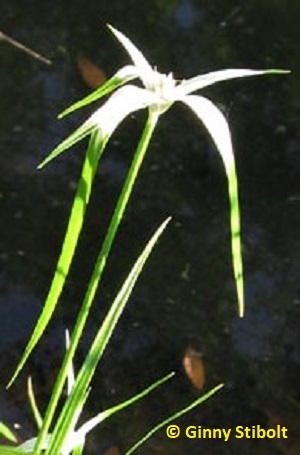 |
White-topped sedge
The native white-topped sedge (Rhynchospora colorata) grows in almost every roadside ditch around my neighborhood. I liberated a few of these odd-looking sedges from a low spot out in the back of our lot and planted them with the ferns next to my pond. Sedges look like a grass, but have triangular stems.
Unlike most grass-like plants, this sedge is insect-pollinated and has developed showy white colorization on the bracts that surround its cluster of flowers in each head. The edges of the white bleed into the green color so it looks like Mother Nature spray-painted the white as an afterthought.
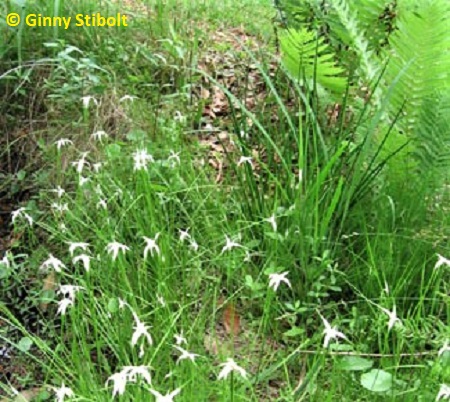 |
The previous owner of our house had sodded this sloping area right to the pond waterline. It was difficult to mow, so one of the first gardening projects I did when we moved in was to remove the grass and replace it with ferns, rain lilies (Zephyranthes atamasco) and this white-topped sedge for a more natural shoreline. Other water-loving volunteers such as primrose-willows (Ludwigia spp), rushes, and other sedges have joined my transplants.
After two years, this end of the pond looks great, especially during the several months when the white-topped sedge is blooming. This natural bank is also easy to maintain and it provides good habitat for our frogs and other critters.
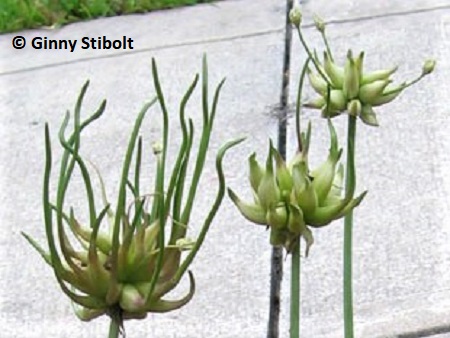 |
Meadow garlic
I found some native meadow garlic (Allium canadense) in the same low spot as the rain lilies and blue-eyed grass (Sisyrichium angustifolium) last year. I created a patch in my herb garden and they've done quite well. I've been clipping their flat, basal leaves to garnish soups or salads—the mild taste is a cross between garlic and onion. This is not surprising since all the onions and garlics are in this genus. If the leaves are flat and not round and hollow, it's a garlic and not an onion.
This spring I've enjoyed their foolproof, wild-haired inflorescence. It includes small six-pedaled white flowers, on long stalks, which will produce seeds if properly fertilized. In addition, this plant produces clones of itself in the form of bulblets. While still attached to the parent plant, the bulblet produces its first wiry leaf. As soon as the leaf emerges, it turns green and starts photosynthesizing. The sugars it produces are stored and the bulblet grows larger and heavier. When a bulblet drops, it falls, bulb-side down like a child's toy top. This way the root area is next to the soil and the leaf points upward and can continue to function using the moisture from the bulb until roots develop enough to bring in moisture from the soil.
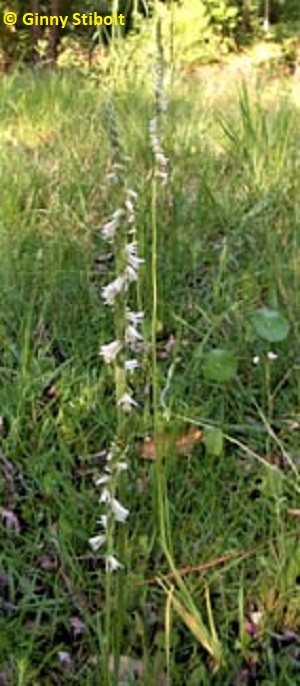 |
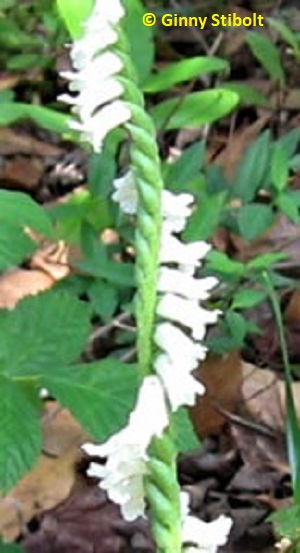 |
Ladies' tresses
In the front meadow and on the edges of the wooded areas ladies' tresses (Spiranthes praecox), a multi-flower orchid, is blooming. The delicate orchid flowers grow in a spiral around the stem. While I'm pretty observant, these beauties surprise me every time, because their basal leaves look just like a grass.
The meadows are such a pleasure to observe, because of delights like this surprising orchid with florets that spiral down the stem. Its genus name, Spiranthes, alludes to this characteristic.
Appreciating the monocots
So while we may plant more dicots in our garden, there are many intriguing monocots to add a dash of interest, a splash of color, and a change of texture.
I've been working hard this spring on removing more lawn and populating our meadows with sunflowers (Helianthus spp.), lupines (Lupinus diffusus) and other wildflowers. Now it's time to relax during the hotter months and enjoy the succession of flowers, bees, butterflies, frogs, and other critters doing what comes naturally.
Enjoy your late spring gardens and wild spaces. See if you can spot your monocots.
Resources:
- For more details on monocots and dicots: www.ucmp.berkeley.edu/glossary/gloss8/monocotdicot.html
- For more details on our meadows, click
here.
- I wrote a profile of the madow garlic for FNPS: A
native herb amongst the Mediterraneans
Ginny Stibolt is a life-long gardener, a botanist, a naturalist, and a garden writer. You may contact her or read more of her articles posted on her website: www.greengardeningmatters.com.
Copyright Ginny Stibolt


